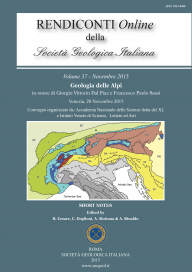
La Zona Sesia-Lanzo e l'evoluzione tettonico-metamorfica delle Alpi nordoccidentali interne: quarant'anni dopo
Giorgio V. Dal Piaz
Istituto Veneto di Scienze Lettere ed Arti, Venezia. Corresponding email: gv.dalpiaz@gmail.com
DOI: https://doi.org/10.3301/ROL.2015.167
Volume: 37/2015
Pages: 24-27
Abstract
The Sesia-Lanzo zone and the tectono-metamorphic evolution of the internal north-western Alps: forthy years later. I would like to remind two articles in which we have first dated the HP metamorphism in the Sesia-Lanzo zone and applied the new global tectonics to the western Alpine collisional belt strictly based on original field and laboratory data, i.e. "La Zona Sesia-Lanzo e l'evoluzione tettonico-metamorfica delle Alpi nordoccidentali interne" (Dal Piaz et al., 1972) and "Alcune considerazioni sulla genesi delle ofioliti piemontesi e dei giacimenti ad esse associati" (Dal Piaz G.V., 1971a). It can be mentioned that, when the memoir on the Sesia-Lanzo zone was printed (Dal Piaz et al., 1972) the classic eclogitic metamorphism extensively exposed in this wonderful basement nappe was firmly considered to be pre-Permian (Bianchi & Dal Piaz, 1963), pre-Carboniferous (Carraro, 1966) or even Caledonian (Mottana, 1972), due to the alleged Permian age of post-metamorphic porphyritic dykes and volcanic cover agglomerates across and over the Sesia-Lanzo zone. It can also be mentioned that, at the beginning of 1970, the tectono-metamorphic evolution of the western and central Alps was considered as a single cycle of burial type and Tertiary age (e.g. Niggli, 1970; Trümpy, 1971). The breakthrough could have been the oral presentation given by Johannes Hunziker of his PhD thesis (1970) in the 45th Swiss annual meeting, but these innovative isotope data of HP metamorphism were so strongly contrasted by an influential Swiss geologist that the paper was not published. Nevertheless a joint collaboration started and the field and laboratory work was systematically improved. Two years later, Hunziker's Rb-Sr and K-Ar ages on white micas from eclogitic micaschists of the Sesia-Lanzo zone and their geodynamic interpretation were presented to the Società Geologica Italiana and published (Dal Piaz et al., 1972; Fig, 1), supporting the existence of a subduction-related tectono-metamorphic event of Late Cretaceous age, called eoalpine (90-65 Ma; detailed isotope data in Hunziker, 1974). This geodynamic interpretation was partly anticipated in a local issue, generally ignored (Dal Piaz, 1971a; Fig. 2). Initial doubts and criticism of geological establishment vanished with finding and dating (31.6 ± 1.3 Ma; Dal Piaz et al., 1973) of a post-metamorphic lamprophyre dyke across the tectonic contact between the Sesia-Lanzo and the underlying Piedmont zone, as well as other Oligocene dykes (32-30 Ma, Dal Piaz et al., 1979) previously supposed Permian, rejuvenating the upper age limit of the HP metamorphism. The eclogitic Sesia-Lanzo zone rapidly became the best evidence that also large and coherent slices of light continental crust could be deeply dragged down into the subduction zone (Dal Piaz et al., 1972; Compagnoni & Maffeo, 1973; Dal Piaz, 1974; Frey et al., 1974; Compagnoni et al., 1975, 1977; Compagnoni, 1977; Gosso, 1977), contrary to theoretical views that ruled out the subduction of continental crust due to its buoyancy (e.g., McKenzie, 1969).
Keywords
Get Full Text